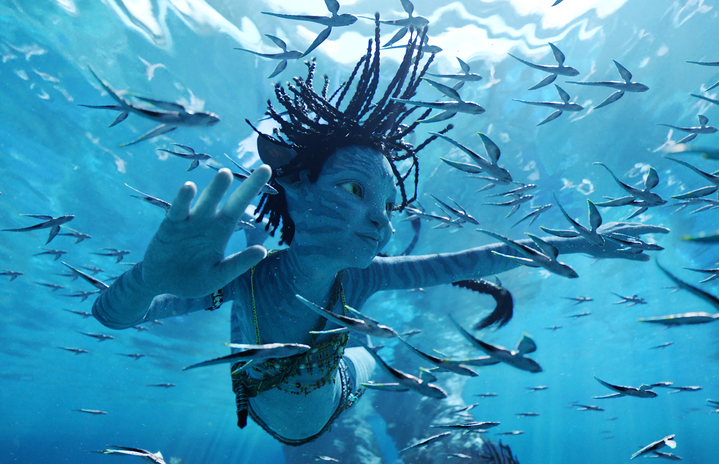Avatar: The Way Of Water is one of the most highly anticipated films of this year, and even arguably the decade. The first Avatar made its debut all the way back in 2009, which is a whopping 13 years prior to the second film’s release. Many have wondered why the sequel has taken so long to come out. Well, that’s simple: The CGI and AI… specifically the underwater CGI and AI (hello, the film is entitled Avatar: The Way Of Water) made this a much more difficult movie to film than your average blockbuster. So, if it was so hard to film the movie, how did they do it?
The advanced technology that it takes to produce a movie like Avatar is truly fascinating. When viewers watch a scene from Avatar, or Avatar: The Way Of Water’s trailer, it may appear that the Na’vi are completely animated creatures. Well, that’s just not the case: There’s actual real life people acting out every movement, sound, and emotion produced by our favorite Na’vi characters. Well, sort of.
If you’ve ever come across a behind-the-scenes video like the one below of the cast and crew creating Avatar: The Way Of Water, chances are you’ll be gobsmacked by what you see. Each actor is decked out head to toe in equipment that allows for an easy animation process to come to life. In addition to that, the sets that they have to work on seem extremely challenging to imagine as the finished product. Really, what we see versus what the actors see on set is drastically different. Their workspace is encompassed by gray sets and production members holding random stand-in objects that will later be transformed into different objects. Essentially, the actors serve as a mold that will later be transformed into what the audience gets to see on screen.
The tech used to create Avatar: The Way Of Water was extremely more advanced than what was needed for the first Avatar movie as well. Director James Cameron is known for paving the way in filmmaking, pushing the boundaries by using technology that has never been used before some of his movies were created. Avatar: The Way Of Water is no different, and Cameron actually struck an incredible breakthrough throughout the film’s creation, successfully utilizing underwater motion capture.
Zoe Saldaña, aka Neytiri, raved about Cameron’s use of underwater motion capture when speaking with Variety. “[Cameron] was finally able to crack that challenge, that whole thing that you can’t imitate water, virtually, through performance capture, […] That was just a challenge that he had taken upon himself, and it took him years, and he did it. He did it. It’s powerful, it’s compelling.”
The real reason that Avatar: The Way Of Water took such a long time to come to fruition is due to the film’s emphasis on water. There were quite a few underwater scenes, meaning that the team behind the movie had to better understand how to navigate CGI and AI in that format. It’s one thing to develop a movie heavily based around CGI and AI in a “land” setting, but adding the literal element of water into the mix makes it even more difficult.
Previously, filmmakers had not been able to utilize motion capture with water, or underwater, to be specific. The general problem with underwater motion capture stems from the fact that when underwater, there is an interface that arises between the air and water. It then acts as a sort of mirror that reflects the dots and markers that are used on the actors, generating “false” markers, making the motion capture hard to generate.
CGI and AI weren’t the only advanced technology used to create the film, though. Cameron dished that the team had to create an all-new camera to effectively shoot the movie that utilizes a 3D system. Once the shots are actually filmed, an algorithm helps transform them into a finished project, so those had to be developed as well. So, yes — Avatar: The Way Of Water was extremely expensive to make. No, really: It cost $250 million to make, and Cameron revealed that the movie would need to “be the third or fourth highest-grossing film in history [to be profitable].”
With that, it’s looking like we won’t have to wait as long to see even more Avatar movies to come in the next few years. Cameron has dished to GQ that the third movie is already filmed, with parts of the fourth already being completed as well, and a script set for a fifth. Thank goodness, because I never want to have to wait another 13 years to experience all that is the Avatar universe again.


